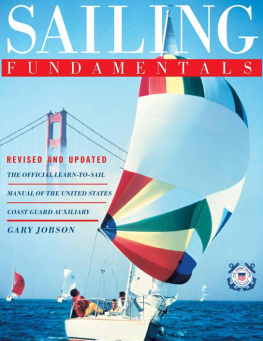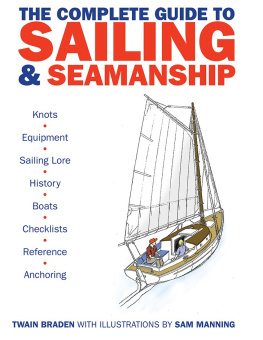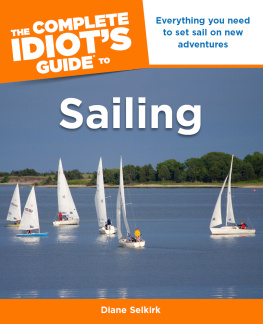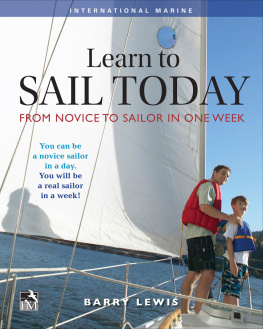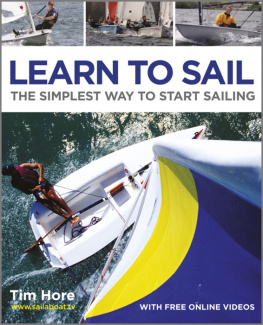SAILING FUNDAMENTALS
The Official Learn-to-Sail Manual of the United States Coast Guard Auxiliary
Revised and Updated
ILLUSTRATION BY MARTI BETZ
BY GARY JOBSON
A TOUCHSTONE BOOK
PUBLISHED BY SIMON & SCHUSTER
New York London Toronto Sydney New Delhi

TOUCHSTONE
Rockefeller Center
1230 Avenue of the Americas
New York, NY 10020
www.SimonandSchuster.com
Copyright 1984 by American Sailing Association
Copyright 1987,1998 by American Sailing
Association and Gary Jobson
All rights reserved, including the right of reproduction in whole or in part in any form.
TOUCHSTONE and colophon are registered trademarks of Simon & Schuster Inc.
Designed by Barbara Marks
Manufactured in the United States of America
10 9 8 7 6
Library of Congress Cataloging-in-Publication Data
Jobson, Gary
Sailing fundamentals.
Includes index.
1. Sailing. 2. American Sailing Association.
1. American Sailing Association. II. Title.
GV811J62 1986 797.l24 86-20338
ISBN-13: 978-0-7432-7308-4
ISBN-10: 0-7432-7308-7
eISBN: 978-1-439-13678-2
DUE TO ONGOING CHANGES IN GOVERNMENTAL SAFETY AND NAVIGATION REGULATIONS, THE PRUDENT SAILOR SHOULD KEEP ABREAST OF ANY SUCH CHANGES SINCE THE DATE OF THIS PUBLICATION BY CONTACTING THE NEAREST U.S. COAST GUARD REPRESENTATIVE.
CONTENTS
PART ONE
INTRODUCTION TO SAILING
PART TWO
BASIC SAILING
PART THREE
SAFETY AND SEAMANSHIP
PART FOUR
BASIC SEAMANSHIP SKILLS
PART FIVE
BASIC COASTAL CRUISING
PART SIX
BASIC COASTAL CRUISING II
PART SEVEN
SPECIAL SAILING INFORMATION
APPENDIX A
Answers to Review Questions
APPENDIX B
Float Plan
APPENDIX C
Accident Report Form
UNITED STATES COAST GUARD AUXILIARY
Sailing Fundamentals is also the official sailing textbook of the United States Coast Guard Auxiliary (USCGAUX). The USCGAUX is the volunteer civilian component of the United States Coast Guard (USCG). It consists of approximately 35,000 members who wish to further their boating education and who provide administrative, operational, and other support to the USCG.
Safe boating education is one of the major missions of the USCGAUX. USCGAUX courses include both classroom and distance-learning (home-study) classes. The USCGAUX does not offer on-the water courses to the general public, although such training is made available to members who wish to engage in search and rescue (SAR), aids to navigation (ATON), and other operational activities that require boat-crew qualification.
The USCGAUX public education program includes special courses for children and the Boating Safely Course (BSC), an eight-hour course for powerboaters, operators of personal watercraft (PWC), hunters and fishermen, and others interested in boating safety. The Skippers Safe Boating course is a distance-learning course for those whose schedules do not permit classroom attendance. The core program includes the Boating Skills and Seamanship (BS&S) course for powerboaters and the Sailing Fundamentals course for sailors. Boaters with an interest in coastal navigation may take the USCGAUX Basic Coastal Navigation (BCN) and Advanced Coastal Navigation (ACN) courses. Members of the USCGAUX are eligible to take advanced training in a variety of topics, including communications, seamanship, SAR, and navigation, and courses on related topics offered through the USCG Institute.
The Skippers Safe Boating Course, BSC, BS&S, and Sailing Fundamentals courses are approved by the National Association of State Boating Law Administrators (NASBLA) and graduates may satisfy state requirements for certification in those states that have mandatory education requirements. (Check with your state Boating Law Administrator [BLA] to see if this course is approved in your state.) Additionally, students who graduate from the S&S course also pass the classroom portion of the ASA Basic Keelboat Sailing Standard.
HOW TO USE THIS BOOK
Each of the first six parts of this book is divided into two sections, Sailing Knowledge and Sailing Skills.
Sailing Knowledge covers terminology, sailing theory, safety, and government regulations-all the things you need to know before going out on the water. To reinforce what you have learned, you will find review questions at the end of each Sailing Knowledge section. Answers are provided in Appendix A.
The Sailing Knowledge sections are covered in detail in the USCGAUX Sailing Fundamentals course. Questions in the written final Sailing Fundamentals examination cover material from the Sailing Knowledge section of each chapter. USCGAUX students are not tested on topics covered only in the Sailing Skills sections (see below), but are encouraged to read this material as a course supplement and in preparation for later on-the-water training offered by ASA schools.
Although this is principally a text about sailing, some of the topics covered in the Sailing Knowledge sections of this book apply to powerboats. This material is included to give the reader additional background and to satisfy the boating-safety education standards set by NASBLA and the USCG. If your vessel has an engine (as many sailboats do) and the engine is in operation-regardless of whether or not the sails are raised-you are considered to be operating a powerboat under the navigation rules and must comply with all regulations applicable to these craft. Moreover, engine equipped vessels must satisfy other federal and state regulations, such as carriage of additional required safety equipment.
The Sailing Skills sections describe exercises and maneuvers designed to teach boat handling. Although the basic principles of sailing are the same for all craft from sailboards to 12-meter yachts, the exercises in this book are designed for a boat of about 14 to 30 feet with at least two people aboard. In practicing each maneuver, switch roles with your fellow crew members so that everyone learns every skill.
Each exercise teaches a particular task. Many of the skills will build upon lessons learned in previous exercises. Each Sailing Skills section is designed to take two to three hours to complete on the water. The ideal way to learn is with the hands-on knowledge imparted by a qualified instructor or experienced sailor. The sequence of exercises in this book allows for a knowledgeable sailor on board with you, although the book itself can be your instructor.
Certain fundamental maneuvers-such as leaving the dock under sail-have purposely been left to later parts. By that point, your skills will have been developed sufficiently for you to attempt these more complicated maneuvers. We deal only with sailboats in Parts One through Four; we will cover handling a vessel under power in Part Five.
Important terms are explained in the text as well as defined in the Glossary beginning on p. 205. Illustrations or photographs give a more detailed explanation of terms when necessary. Each subject area is explored in increasing depth in subsequent parts as you gain knowledge and develop basic skills.
Good luck and smooth sailing.
PART ONE
Introduction to Sailing

OVERVIEW: THE SAILBOAT AND THE WIND
To illustrate the way the wind interacts with the sails, let me tell you a story.

